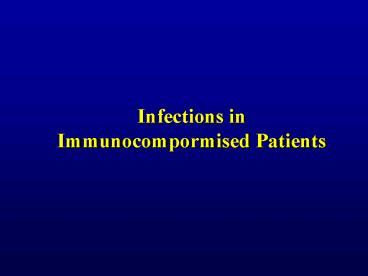Infections in Immunocompormised Patients - PowerPoint PPT Presentation
1 / 14
Title:
Infections in Immunocompormised Patients
Description:
Often due to myelosuppression by antineoplastic therapy ... High risk of life threatening infection ... D/C all therapy after 5 afebrile days ... – PowerPoint PPT presentation
Number of Views:141
Avg rating:3.0/5.0
Title: Infections in Immunocompormised Patients
1
Infections in Immunocompormised Patients
2
Factors Compromising Immunity
- Neutropenia
- Impaired cell mediated immunity
- Humoral immune dysfunction
- Splenectomy
- Damage to mucosal surfaces
- Breaks of anatomical barriers
- Local factors
3
Neutropenia
- Often due to myelosuppression by antineoplastic
therapy - Infection depends on degree and duration of
neutropenia - Neutrophil lt 500/mm3 High risk of infections
- Neutrophil lt 100/mm3 High risk of life
threatening infection - Most patients fail to develop characteristic
signs of infection. - Only 30 of febrile patients have ve blood
cultures. - Commonest source of pathogens is GIT.
- Fungal infections occur late in prolonged
neutropenia. - Consider other causes of fever.
4
Infections in Neutropenic Patients
- Common sites of Infections
- Oropharynx, lung, paranasal sinuses, skin soft
tissues, perianal area, urinary tract. - Infections are often caused by organisms
colonising the patient
5
Infections in Neutropenic Patients
- Bacterial infections
- Gram ve bacteria are the most common .
- Gram ve cocci increased recently.
- Anaerobes are uncommon.
6
Infections in Neutropenic Patients
Fungal infections
- Frequent in patients with prolonged neutropenia
- Candida sp.
- Superficial infections
- Candidemia invasive candidiasis
- Invasive aspergillosis (pneumonia)
- Other fungi mucormycosis, pseudoallescheria,
fusarium
7
Infections in Neutropenic Patients
Viral infections
- Herpes simplex
- Herpes zoster
- Cytomegalovirus
8
Infections in Neutropenic Patients
Patient Evaluation
- Initial clinical evaluation
- Septic workup
- Laboratory tests
- Radiological imaging
- Invasive procedures
9
Infections in Neutropenic Patients
Emperical Therapy
- Rationale
- Febrile neutropenic patients
- 50 have clinical or microbiological evidence of
focus or cause of infection - 50 have unexplained fever
- 35 respond to emperical therapy
- 15 donot respond
Further diagnostic therapeutic
procedures
10
Infections in Neutropenic Patients
Empirical Therapy
- Initial regimen to cover gram ve baccilli
- Broadspectrum b lactum Aminoglycosids
- Carbapenem
- B-lactam allergy quinolone / aztreonam
- Add vancomycin if evidence of Gramve infection
or failure to respond - Add Amphorencin B if fail to repond after 5
days of therapy.
11
Infections in Neutropenic Patients
Empirical therapeutic regimens
- No significant difference in efficacy of regimens
- Regimen should cover locally prevalent pathogens
- Most patient respond within 4-5 days
- Failure to respond after 5 days modify therapy
12
Infections in Neutropenic Patients
Empirical therapy
- Remove central venous catheter if persistent
bactromia / fungemia - Response depends on recovery of neutropenia
- D/C all therapy after 5 afebrile days
- No need to continue amphotrecin if no evidence of
invasive mycosis - Specific therapy for documented infections
13
(No Transcript)
14
(No Transcript)































